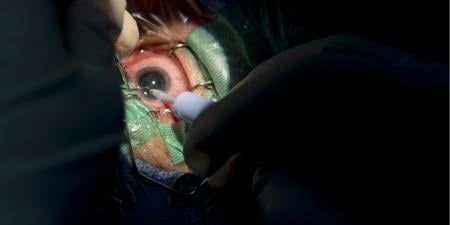The term “glaucoma” refers to a range of disorders that cause progressive damage to the optic nerve. Glaucoma was long defined as gradual vision loss due to elevated pressure in the eye. The elevated pressure is the results of a “clogging” of the trabecular meshwork, the apparatus through which intraocular fluid (or aqueous humor) drains out of the eye. It is now known, however, that, although intraocular pressure is a leading risk factor, other mechanisms are clearly involved [1]. A third of people with glaucoma do not have elevated intraocular pressure (it may even be low) [2], and those with high pressure do not necessarily develop glaucoma. Alterations in the lamina cribosa and fluctuations in perfusion pressure are thought to play a role, but the exact etiology of these changes remains unknown. The diagnosis is now made on the basis of two criteria: visible damage to the optic nerve and loss of peripheral vision [2].
Clinical Presentation
Glaucoma is known as a “silent killer” of vision because it is frequently asymptomatic until later stages. (It is estimated that up to 50 percent of people with the disease remain undiagnosed [1] and in developing countries, the percentage is even higher [3].) Pain is not a feature of the disease until the intraocular pressure is extremely high, and since central vision is spared for a long time—it may remain 20/20 even when the condition is very advanced—patients may not notice the initial peripheral visual field loss. In children, enlargement of the eye can occur with increased intraocular pressure, along with sensitivity to light and clouding of the cornea [4].
Classification
There are several types of glaucoma. Primary open-angle glaucoma (POAG) is the most common type, affecting over 3 million Americans [1]. This type of glaucoma has three typical features: (a) an intraocular pressure consistently above 21 mmHg in at least one eye; (b) an open, apparently normal anterior chamber angle; and (c) glaucomatous optic neuropathy or visual field defect. In acute angle-closure glaucoma, elevated intraocular pressure is caused by an anatomical obstruction of the trabecular meshwork by the peripheral iris. The condition is characterized by the sudden onset of severe pain, blurred vision, and redness [5]. Patients who have optic nerve damage with normal intraocular pressure are said to have normal-tension glaucoma. Optic nerve damage that develops as a complication of another medical or eye condition, such as trauma or certain eye tumors, is referred to as secondary glaucoma [6].
Diagnosis and Prevention
Early detection through regular and comprehensive dilated eye exams is the key to preventing damage from glaucoma. Glaucoma can develop at any age, but after the age of 40, every person should have a regular eye exam every 1 to 3 years, depending on risk factors. African Americans, people of Hispanic origin, anyone over the age of 60, and those with a family history of glaucoma are at increased risk.
This exam should include a measurement of intraocular pressure and an examination of the optic nerve, which shows a characteristic excavated or cupped appearance as more and more nerve fibers are damaged [6]. If the optic nerve appears abnormal, a perimetry or visual field test should be done to evaluate the patient’s peripheral vision more precisely. Various other imaging modalities can be used to analyze the optic nerve further [1]. A survey done for the Glaucoma Research Foundation found that 74 percent of roughly 1,000 respondents had their eyes examined once every 2 years, but only 64 percent of those examined received a dilated eye exam, which is the best way to identify suspected glaucoma [1].
Treatment
Early treatment can prevent progression of the disease in a majority of people. Unfortunately, there is no cure, and vision, once lost, cannot be regained. Up to 10 percent of patients continue to lose vision despite proper treatment [1]. Compliance is crucial to the efficacy of glaucoma treatment. Since the condition is often asymptomatic, many patients do not take their treatment seriously [2].
Currently available treatments for glaucoma work by lowering the pressure in the eye [2]. Large randomized trials have shown that lowering intraocular pressure effectively prevents disease progression, even in normal-tension glaucoma [7]. Pressure can be reduced with eyedrops, laser treatment, surgery, or a combination of these methods.
Pressure-lowering drops are the most common treatment for glaucoma and usually the first-line treatment. Because these drops vary in their effect on the eye (some reduce fluid production, others speed up drainage) [6], a combination of several eyedrops may be used. Each type of drop is associated with its own set of adverse effects, and not all patients are candidates for every type of drop.
Laser treatment or surgery can be used when medical treatment has not produced the desired intraocular pressure or when patients do not adhere to their eye drop regimen [6]. Both modes of treatment aim to increase aqueous humor drainage from the eye. Laser treatment is usually attempted prior to surgery; since it tends to provide less reduction in intraocular pressure, it is considered appropriate in less severe cases. Oral medications such as acetazolamide are frequently used, along with eyedrops, to control pressure until surgery can be performed. (They are generally only used in these temporary circumstances, because their side effects can be very bothersome, and chronic use could lead to severe adverse events [1].)
Current research is investigating the effect of medications used in other neurodegenerative disorders, such as Alzheimer disease and multiple sclerosis, on progression of glaucoma. There is hope that what works in one neurodegenerative disorder might work in another [2].
The treatment of pediatric glaucoma differs somewhat from that of glaucoma in adults [1]. In addition to compliance challenges and efficacy concerns, most of the commonly used eyedrops carry particular risks for children (for example, brimonidine drops have been shown to cause central nervous system depression in children). Though medications are the initial and, often, the mainstay treatment for juvenile open-angle glaucoma and some pediatric secondary glaucomas [5], surgery is the main intervention for primary congenital glaucoma and pediatric closed-angle glaucomas.
Conclusion
According to the World Health Organization (WHO), glaucoma is thought to be a leading cause of blindness worldwide, second only to cataracts. It presents the most significant public health challenge, however, because it is irreversible. In their paper on global visual impairment statistics gathered by the WHO, Resnikoff and colleagues found that the world population aged 50 years and older had increased by 30 percent since 1990 [3]. Glaucoma will become an increasingly pressing concern as the population ages, and it is our responsibility to educate the public about preserving vision before it is too late.
References
-
Glaucoma Research Foundation. What is glaucoma? http://www.glaucoma.org/learn/what_is_glaucom.php. Accessed October 1, 2010.
-
Peter J. A new understanding of glaucoma. The New York Times. July 16, 2009. http://health.nytimes.com/ref/health/healthguide/esn-glaucoma-ess.html. Accessed October 1, 2010.
- Resnikoff S, Pascolini D, Etya’ale D, Kocur I. Global data on visual impairment in the year 2002. Bull World Health Organ. 2004;82(11):844-851.
- Khaw PT, Shah P, Elkington AR. Glaucoma—1: diagnosis. BMJ. 2004;328(7431):97-99.
-
Allingham R, Shields MB, Freedman S. Shield’s Textbook of Glaucoma. 5th ed. Philadelphia, PA: Lippincott Williams and Wilkins; 2005.
-
National Eye Institute Healthy Information. Facts about glaucoma. http://www.nei.nih.gov/health/glaucoma/glaucoma_facts.asp. Accessed October 1, 2010.
- Khaw PT, Shah P, Elkington AR. Glaucoma—2: treatment. BMJ. 2004;328(7432):156-158.



